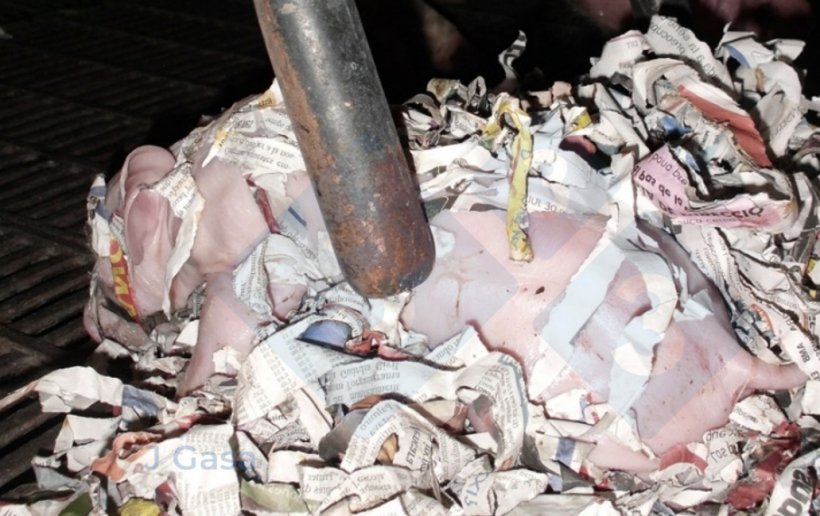原文
Vande Pol KD, Tolosa AF, Shull CM, Brown CB, Alencar SAS, Ellis M. Effect of drying and warming piglets at birth on preweaning mortality. Translational Animal Science. 2021; 5(1): txab016. doi: 10.1093/tas/txab016

来自Josep Gasa的学术性评论
尽管该研究涵盖了来自800窝超过10000头仔猪的哺乳情况,仍然印证了产房里母畜管理方面的研究很难取得结论性的成果。
该研究的初衷是为了弄清楚擦干新生仔猪及为其补充热源对断奶重和断奶前死亡率的影响,并进行了两种处理:
- 对照组
- 实验组(擦干新生仔猪并在36.7 ºC下保温 30 min)
仔猪在出生和断奶时两次称重,记录哺乳期仔猪的死亡率,10%的母猪所产的仔猪在出生和出生后30 min两次监测直肠温度。产房里的温度也被记录下来。
最初的结果显示,与对照组相比,实验组仔猪出生后30 min直肠温度升高2.33°C,但对断奶前死亡率或仔猪断奶重没有影响,从数值上看实验组仔猪的断奶重甚至比对照组更低(5.23 vs. 5.35 kg)。
接下来,研究人员分析了两个新的变量:
a) 根据产房中环境温度的均值大小,仔猪被分为两组:
- <25 ºC,凉爽环境
- >25 ºC,温暖环境
b) 每窝的仔猪按照体重大小被分为三组:
- 轻(<1.0 kg)
- 中等(1.0 - 1.5 kg)
- 重(>1.5 kg)
比较实验组和对照组,结果发现,只有在凉爽环境下实验组才显著降低了仔猪断奶前死亡率(14.8% vs. 17.2%),而在温暖环境中则没有此影响(16.2% vs. 15.9%)。而仔猪断奶重并没有受到试验处理的影响,且凉爽环境下比温暖环境下断奶重数值更高(5.77 vs 4.98)。这些结果提示,试验处理只在温度中等或次佳(<25 °C)的产房中有利于分娩后数小时或数天内仔猪的存活。而较高的产房温度(>25 °C)可能妨碍仔猪的生长。
最后,作者指出,影响断奶前死亡率和仔猪断奶重的最大因素出生活重。不考虑实验处理的影响,体重较轻和较重的仔猪其断奶前死亡率分别在44.6%和 8.2%左右,对应的断奶重分别为 3.73 kg和5.86 kg 。
简而言之,由于高产母猪的仔猪出生重一般较低,建议额外对新生仔猪进行干燥和保温;此外,分娩临近时,如果产房温度处于次佳状态,也建议这么做。冬季很多农场也可能会出现这种情况,尽管本试验是在2018年4月至11月期间的美国印第安纳州进行的。
来自Josep Casanovas的实践性评论
该研究旨在阐明一个被认为十分必要的管理实践,非常有意义。
哺乳动物有两种类型,一种出生时已发育完全且已具备一定的独立性,比如牛、羊等动物;另一种出生时尚未发育完全,比如人类、小鼠、猫、狗等。
若娩出的后代未完全发育,这样的雌性哺乳动物需要巢穴,这会刺激子宫内环境直至子代发育完全。
而猪属于哪一种类型呢?
仔猪在出生时并非完全独立,它们大约需要3天时间来完成发育并实现相对独立。
在产房中饲养着截然不同的两种类型的猪:体重超过220 kg的母猪和1-10 kg重的仔猪。

不同特点的动物对环境的需求不同。产房内饲养的仔猪需要一个巢穴,一个出生后第一周内环境温度在 30ºC左右的休息区域。
对于哺乳动物来说,分娩时间对于母畜和仔畜的存活都至关重要。
分娩时,仔畜的温度调节机制首次启动,这往往发生于仔畜缺少能量储备时。
为了便于娩出,仔畜出生时非常纤瘦,没有任何脂肪组织,这是为了能顺利通过产道。而脂肪组织是储备能量的仓库。
大多数母畜会在分娩后舔舐仔畜,以使得仔畜身体迅速干燥并刺激它们开始吮乳。
初乳中除了含有丰富的抗体来保护仔畜免受可能的感染,还有能量物质,吮吸初乳能够使仔畜尽快恢复能量水平。
干燥仔畜的身体并摄入初乳是确保新生仔畜存活的关键。
母猪没有在分娩后舔舐仔猪,因为它们没有能力这样做。体格的差异会加剧仔猪间的挤压。母猪不能像母狗那样可以将鼻子伸到身体的后驱。
在上个世纪,40多年前,Peter English在出生后数小时内对新生仔猪的直肠温度进行了检测,所得到的结果和本研究的结果十分类似。 Figure 2. 仔猪直肠温度趋势(从出生到35h,按初生重分组)。 数据来源: Pattison, English, MacPherson, and Birnie 1989._278402.jpg?w=820&q=1&t=1728944075)
出生时,仔猪直肠温度约为38.7 ºC,这符合逻辑,因为这是母猪或所有猪的正常体温。
分娩后30min,未经任何处理的仔猪直肠温度为35.65 ºC(比猪的正常体温低3 ºC ),而经过擦干身体并置于热源下的仔猪直肠温度为37.98 ºC (比猪的正常体温低0.7 ºC )。
相差3 ºC,已然很显著。想象一下,如果有一天读者您测一下自己的体温,显示的是33.7 ºC 而不是36.7 ºC,你会作何感想。
在这种情况下,你会怎么样?相信你会非常担忧。
我认为该研究存在几个重要的局限性。
一方面,给仔猪提供半小时的热源却不提供初乳,时间似乎太长;另一方面,“温暖”区域的温度很可能过高。该研究提供的数据显示,在热源下温度为37.1 +/- 3.22 ºC,事实上34 ºC已经足够。
在当时,每窝断奶超过10头仔猪已经是很大的挑战,分娩后的几天使用报纸意味者能够多断奶一头仔猪。新闻用纸被拿来擦干仔猪的身体并作为垫子将仔猪与地板隔开,将仔猪休息区的体感温度提升了几度。
该研究认为,擦干仔猪的身体非常值得,甚至是利他的做法,如此能够确保仔猪的健康,这样便能尽快恢复体温。
原文概要Vande Pol KD, Tolosa AF, Shull CM, Brown CB, Alencar SAS, Ellis M. Effect of drying and warming piglets at birth on preweaning mortality. Translational Animal Science. 2021; 5(1): txab016. doi: 10.1093/tas/txab016 方法: This study evaluated the effect of drying and warming piglets at birth on preweaning mortality and weaning weight under commercial conditions. A completely randomized design was used with 802 sows/litters (10,327 piglets); sows/litters were randomly allotted at the start of farrowing to one of two Intervention Treatments (applied at birth): Control (no drying or warming); Drying+Warming (dried with a cellulose-based desiccant and placed in a box under a heat lamp for 30 min). Piglets were weighed at birth and weaning; preweaning mortality was recorded. Rectal temperature was measured at 0 and 30 min after birth on all piglets in a subsample of 10% of litters. The effect of farrowing pen temperature on weaning weight and preweaning mortality was evaluated by comparing litters born under COOL (<25°C) to those born under WARM (≥25°C) farrowing pen temperature. The effect of birth weight on weaning weight and preweaning mortality was evaluated by comparing three birth weight categories (Light: <1.0 kg, Medium: 1.0 to 1.5 kg, or Heavy: >1.5 kg). PROC GLIMMIX and MIXED of SAS were used to analyze mortality and other data, respectively. Litter was the experimental unit; piglet was a subsample of litter. The model included fixed effects of Intervention Treatment, and farrowing pen temperature or birth weight categories as appropriate, the interaction, and the random effects of litter. 结果: Piglet rectal temperature at 30 min after birth was greater for the Drying+Warming than the Control treatment (+2.33°C). Overall, there was no effect of Intervention Treatment on preweaning mortality or weaning weight, and there were no Intervention Treatment by birth weight categories interactions for these measurements. There was an Intervention Treatment by farrowing pen temperature interaction for preweaning mortality. Drying and warming piglets reduced preweaning mortality under COOL (by 2.4 percentage units) but not WARM farrowing pen temperature. In addition, weaning weights were lower under WARM (by 0.79 kg) than COOL farrowing pen temperature; however, there was no interaction with Intervention Treatment. 结论: This study suggests that drying and warming piglets at birth increases rectal temperature and may reduce preweaning mortality under cooler conditions, which are typically experienced in temperate climates during the majority of the year. |




